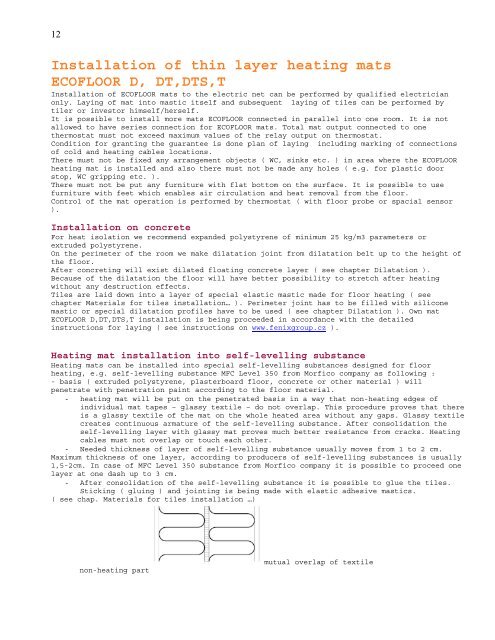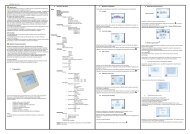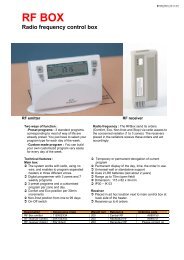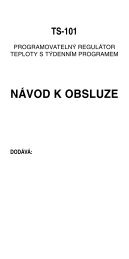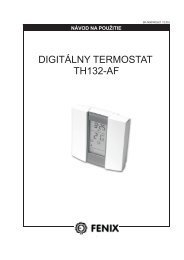download - Fenix
download - Fenix
download - Fenix
You also want an ePaper? Increase the reach of your titles
YUMPU automatically turns print PDFs into web optimized ePapers that Google loves.
12<br />
Installation of thin layer heating mats<br />
ECOFLOOR D, DT,DTS,T<br />
Installation of ECOFLOOR mats to the electric net can be performed by qualified electrician<br />
only. Laying of mat into mastic itself and subsequent laying of tiles can be performed by<br />
tiler or investor himself/herself.<br />
It is possible to install more mats ECOFLOOR connected in parallel into one room. It is not<br />
allowed to have series connection for ECOFLOOR mats. Total mat output connected to one<br />
thermostat must not exceed maximum values of the relay output on thermostat.<br />
Condition for granting the guarantee is done plan of laying including marking of connections<br />
of cold and heating cables locations.<br />
There must not be fixed any arrangement objects ( WC, sinks etc. ) in area where the ECOFLOOR<br />
heating mat is installed and also there must not be made any holes ( e.g. for plastic door<br />
stop, WC gripping etc. ).<br />
There must not be put any furniture with flat bottom on the surface. It is possible to use<br />
furniture with feet which enables air circulation and heat removal from the floor.<br />
Control of the mat operation is performed by thermostat ( with floor probe or spacial sensor<br />
).<br />
Installation on concrete<br />
For heat isolation we recommend expanded polystyrene of minimum 25 kg/m3 parameters or<br />
extruded polystyrene.<br />
On the perimeter of the room we make dilatation joint from dilatation belt up to the height of<br />
the floor.<br />
After concreting will exist dilated floating concrete layer ( see chapter Dilatation ).<br />
Because of the dilatation the floor will have better possibility to stretch after heating<br />
without any destruction effects.<br />
Tiles are laid down into a layer of special elastic mastic made for floor heating ( see<br />
chapter Materials for tiles installation… ). Perimeter joint has to be filled with silicone<br />
mastic or special dilatation profiles have to be used ( see chapter Dilatation ). Own mat<br />
ECOFLOOR D,DT,DTS,T installation is being proceeded in accordance with the detailed<br />
instructions for laying ( see instructions on www.fenixgroup.cz ).<br />
Heating mat installation into self-levelling substance<br />
Heating mats can be installed into special self-levelling substances designed for floor<br />
heating, e.g. self-levelling substance MFC Level 350 from Morfico company as following :<br />
- basis ( extruded polystyrene, plasterboard floor, concrete or other material ) will<br />
penetrate with penetration paint according to the floor material.<br />
- heating mat will be put on the penetrated basis in a way that non-heating edges of<br />
individual mat tapes – glassy textile – do not overlap. This procedure proves that there<br />
is a glassy textile of the mat on the whole heated area without any gaps. Glassy textile<br />
creates continuous armature of the self-levelling substance. After consolidation the<br />
self-levelling layer with glassy mat proves much better resistance from cracks. Heating<br />
cables must not overlap or touch each other.<br />
- Needed thickness of layer of self-levelling substance usually moves from 1 to 2 cm.<br />
Maximum thickness of one layer, according to producers of self-levelling substances is usually<br />
1,5-2cm. In case of MFC Level 350 substance from Morfico company it is possible to proceed one<br />
layer at one dash up to 3 cm.<br />
- After consolidation of the self-levelling substance it is possible to glue the tiles.<br />
Sticking ( gluing ) and jointing is being made with elastic adhesive mastics.<br />
( see chap. Materials for tiles installation …)<br />
non-heating part<br />
mutual overlap of textile


